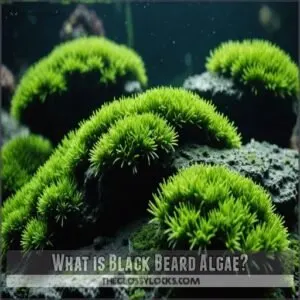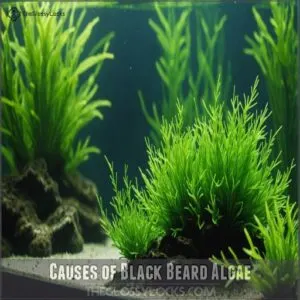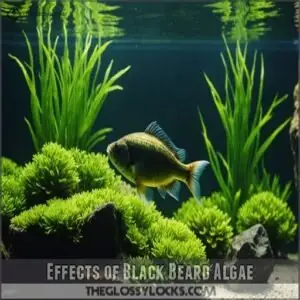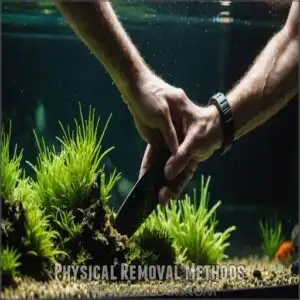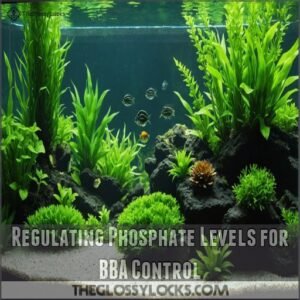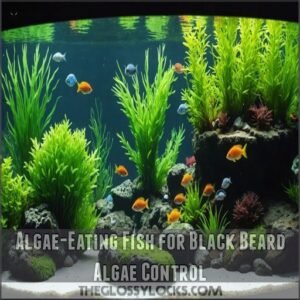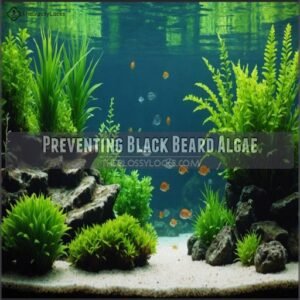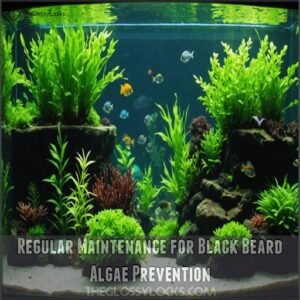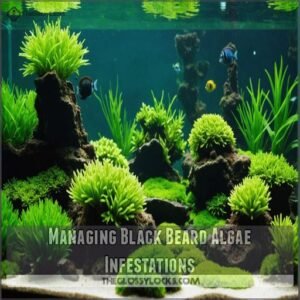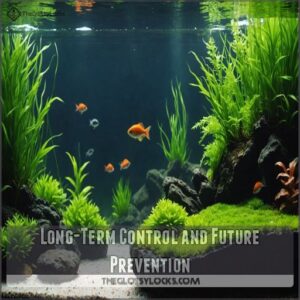This site is supported by our readers. We may earn a commission, at no cost to you, if you purchase through links.

To get rid of this pesky invader, start by manually removing affected leaves and decorations.
Then, arm yourself with diluted hydrogen peroxide and give those stubborn patches a good spritz.
Boost your tank’s CO2 levels to make life uncomfortable for the algae, and keep an eye on those phosphates – they’re like algae candy.
Introducing some algae-eating fish can turn your cleanup crew into an all-you-can-eat buffet for your finned friends.
Remember, consistency is key in this aquatic battle.
But wait, there’s more to this algae-busting adventure than meets the eye…
Table Of Contents
- Key Takeaways
- What is Black Beard Algae?
- Causes of Black Beard Algae
- Effects of Black Beard Algae
- Removing Black Beard Algae
- Algae-Eating Fish for Black Beard Algae Control
- Preventing Black Beard Algae
- Regular Maintenance for Black Beard Algae Prevention
- Managing Black Beard Algae Infestations
- Long-Term Control and Future Prevention
- Frequently Asked Questions (FAQs)
- How to remove black beard algae?
- How do you get black beard algae in an aquarium?
- Is black beard algae a problem?
- Can black beard algae be removed from a fish tank?
- What is the best way to get rid of black beard algae?
- Why am I getting black beard algae?
- What eats black beard algae in aquarium?
- What is the best algaecide for black beard algae?
- Can black beard algae spread to other aquariums?
- Is black beard algae harmful to fish?
- How long does it take to eradicate BBA?
- Can medications or chemicals eliminate black beard algae?
- Does BBA prefer certain types of aquarium plants?
- Conclusion
Key Takeaways
- Cut off affected leaves and decor to physically remove black beard algae, making your tank look better instantly.
- Boost CO2 levels to promote plant growth and inhibit algae, creating an environment where algae don’t thrive.
- Use hydrogen peroxide treatments or add algae-eating fish, like Siamese algae eaters, to actively combat black beard algae.
- Perform regular water changes and monitor nutrient levels to prevent algae from getting a foothold in your aquarium.
What is Black Beard Algae?
If you’ve noticed a fuzzy, black growth that looks like a scruffy beard in your aquarium, which can be reminiscent of the coarse or patchy beards that African American men often have. you’re probably dealing with Black Beard Algae (BBA).
While it’s not harmful to your fish, this stubborn red algae (yep, it’s actually red despite looking black) can cling to everything from plants to decorations, making your tank look like it needs a good shave.
Black Beard Algae Identification
You’ll often spot Black Beard Algae (BBA) lurking in your aquarium like an unwanted houseguest.
This pesky algae isn’t actually black – it’s a type of red algae that just looks dark and fuzzy.
Think of it as the stubborn 5 o’clock shadow of the aquarium world.
It loves clinging to your equipment, plants, and decor, making your tank look like it’s growing a scruffy beard.
Characteristics of Black Beard Algae
Now that you’ve spotted this unwelcome guest, let’s get to know what makes Black Beard Algae tick.
This stubborn aquarium crasher really lives up to its name.
If the infestation has gotten out of hand, consider using specialized tools like a black beard algae remover.
Here’s what sets it apart:
- Dark fuzzy patches that look like a scruffy beard
- Starts as tiny spots, then spreads like wildfire
- Clings to everything – plants, decor, even snail shells
- Has a tough, brush-like texture that’s hard to budge
It’s not harmful to fish, but it’s definitely a party crasher you’ll want to show the door!
Mistaken Identity With Staghorn Algae
Let’s clear up a common mix-up – Black Beard Algae isn’t the same as Staghorn algae!
While both can be real troublemakers in your tank, they’ve got distinct looks.
BBA appears as short, dark tufts that stick to surfaces like an unruly beard, whereas Staghorn branches out in long, grey-green strands that look like deer antlers.
Telling them apart is key because each needs its own battle plan for removal.
Causes of Black Beard Algae
If you’re noticing black beard algae in your aquarium, chances are your tank’s having a bit of a chemistry crisis.
Your plants are struggling due to an imbalance of nutrients, CO2 levels, or lighting – it’s like they’ve invited an unwanted houseguest who’s decided to overstay their welcome.
Excess Nutrients and Poor Water Quality
That fuzzy black menace loves to feast on excess nutrients in your tank.
Think of your aquarium as a buffet – overfeeding your fish or skipping water changes creates an all-you-can-eat spread for Black Beard Algae.
Hard water, which can be caused by high mineral levels, can also contribute to poor water quality.
Your filter might be struggling to keep up, letting phosphates and nitrates build up.
Regular testing reveals what’s cooking in your tank’s kitchen, helping you cut off the algae’s food supply.
Low or Fluctuating CO2 Levels
Your aquarium’s CO2 levels can make or break the battle against Black Beard Algae.
When CO2 fluctuates or stays low, your plants struggle to grow, leaving plenty of nutrients for pesky algae to feast on.
Think of CO2 as your plants’ favorite energy drink – without a steady supply, they’ll lose the competition for resources.
Try using a drop checker to monitor levels, or consider adding liquid carbon like Seachem Flourish Excel as a CO2 booster.
Excessive Light and Its Effects
Finding the sweet spot with aquarium lighting can feel like walking a tightrope.
CO2 isn’t the only factor – too much light acts like a free buffet for black beard algae.
When you blast your tank with intense lighting, you’re basically rolling out the red carpet for these unwanted guests.
- Light-loving algae can outcompete your plants, turning your aquascape into their personal playground
- Shorter lighting periods (6-8 hours) keep algae in check while still letting your plants thrive
- Think of light like seasoning – just enough enhances the dish, but too much spoils everything
Overdosing Fertilizers and Waste Buildup
Let’s face it – even fish tanks can get a nutrient hangover!
Overdosing aquarium fertilizers is like serving your plants an all-you-can-eat buffet, but Black Beard algae crashes the party.
When you mix excessive nutrients with waste buildup from uneaten fish food and decaying plant matter, you’re basically rolling out the red carpet for algae growth.
Think of it as turning your tank into an algae spa – luxurious for them, headache for you!
Effects of Black Beard Algae
While black beard algae won’t directly harm your fish, it’ll definitely cause headaches for your aquarium plants by blocking their light and stunting their growth.
You’ll notice your once-thriving underwater garden looking less vibrant as this stubborn, brushy invader competes for nutrients and makes your tank look like it’s growing a 5 o’clock shadow.
Is Black Beard Algae Harmful to Fish?
Now that you know what causes black beard algae (BBA), you’re probably wondering if it’ll hurt your fish.
Good news – BBA isn’t directly toxic to your finned friends!
While it looks unsightly, most fish swim by it without a care in the world.
For effective control, consider using specialized products for Aquarium Algae Control.
Still, it’s best to keep BBA under control for a healthier tank overall.
Impact on Plant Growth and Aquarium Ecosystem
While black beard algae might seem like just an eyesore, it’s actually playing dirty with your aquarium plants, much like how a grey beard can make a person appear older than their actual age, as seen in how grey beards affect age perception.
This pesky invader blocks precious light from reaching your leafy friends, effectively putting them in a chokehold.
Your aquatic plants can’t photosynthesize properly, leading to stunted growth and yellowing leaves.
As if that weren’t enough, BBA disrupts your tank’s delicate ecosystem balance by hogging nutrients your plants desperately need to thrive.
Removing Black Beard Algae
You’ll be happy to know that getting rid of black beard algae isn’t as hard as it looks, even though it can be as stubborn as your uncle’s actual beard.
From using hydrogen peroxide treatments to boosting CO2 levels, you’ve got several effective weapons in your algae-fighting arsenal that’ll help you restore your tank to its former glory.
Physical Removal Methods
Physical removal puts you back in control of your tank’s look.
Start by scraping off the pesky black beard algae from your plants and decor – it’s like giving your aquarium a much-needed haircut! Grab an algae scrubber or old toothbrush and gently brush away those dark tufts.
For stubborn patches on leaves, simply trim them off.
Don’t forget to remove any floating bits with a net – you’ll instantly see your tank’s beauty shine through again.
Hydrogen Peroxide Treatment for BBA
Maintaining a healthy beard through a balanced beard care routine, which includes regular washing, moisturizing, and trimming, is key to preventing issues like itchiness and dryness. Bubbling with potential, hydrogen peroxide treatment is your secret weapon against stubborn Black Beard Algae.
This aquarium superhero works like magic when you know the tricks.
Here’s your battle plan:
- Use a 3% hydrogen peroxide solution – it’s tough on algae but gentle on your aquatic pals
- Spot treat affected areas using a syringe for precise application
- Keep treatment time to 3 minutes max to protect your plants and fish
Watch as that pesky BBA turns pink, signaling its defeat!
CO2 Boosting to Inhibit BBA Growth
You can kick BBA to the curb by cranking up your CO2 levels.
Think of CO2 as your secret weapon – it gives your plants a growth boost while making life tough for algae.
Start with a DIY CO2 system or invest in a pressurized setup.
Aim for that sweet spot of 30 ppm, and you’ll see your plants thriving and BBA retreating.
Just remember, consistency is key – keep those CO2 levels steady!
Regulating Phosphate Levels for BBA Control
The sneaky culprit behind stubborn BBA might be hiding in your phosphate levels.
Start with a reliable phosphate test kit to check your water parameters – think of it as taking your tank’s temperature.
Add phosphate-binding media to your filter, and switch to low-phosphate fish foods.
Regular water changes work wonders too, keeping those pesky nutrients in check while your plants thrive.
Algae-Eating Fish for Black Beard Algae Control
If you’re tired of scrubbing black beard algae off your tank decorations, you’ll love having a cleanup crew of fish that’ll happily munch on it for you.
These aquatic helpers, especially the Siamese algae eater, won’t just add life to your tank – they’ll work around the clock to keep those pesky black tufts under control.
Introducing Siamese Algae Eaters and Other Species
Natural allies in your fight against black beard algae, just as African American men rely on best beard care products like beard butter for their facial hair, Siamese algae eaters work like tiny underwater vacuum cleaners.
These fish, along with Amano shrimp and cherry shrimp, form your aquatic cleanup crew.
Before adding these helpers to your tank, remember to quarantine them for two weeks.
Once settled, they’ll patrol your tank’s surfaces, munching away at that pesky algae like microscopic landscapers.
Benefits and Limitations of Algae-Eating Fish
While algae-eating fish can be your aquatic cleanup crew, they’re not miracle workers.
Consider tank size before adding these helpful swimmers – they’ll need proper space to thrive.
Some species might nibble on your plants instead of targeting black beard algae, and others could reproduce rapidly, causing overpopulation.
For best results, pair these finned friends with other control methods and maintain ideal water conditions.
Preventing Black Beard Algae
You’ll save yourself a lot of headaches by stopping black beard algae before it gets a foothold in your aquarium, just like preventing a cold is easier than treating one.
By following smart prevention strategies like sterilizing new items and maintaining stable CO2 levels, you’ll create an environment where this pesky algae won’t want to crash your underwater party.
Sterilizing New Aquarium Items and Quarantine
How can you protect your aquatic paradise from sneaky black beard algae?
Start your new tank setup right by sterilizing everything that goes in, similar to how you’d prepare your skin for a permanent hair removal treatment like electrolysis for hair.
You’ll want to bleach dip your plants in a 1:20 solution for 2-3 minutes, and quarantine new fish for at least two weeks.
Don’t forget to sterilize decorations with hot water treatment or a hydrogen peroxide bath – it’s like giving your aquarium items a spa day!
Adding Fast-Growing Plants for Nutrient Competition
By introducing fast-growing plants, you’ll create nature’s own defense squad against pesky black beard algae.
Think of these plants as hungry competitors in an all-you-can-eat buffet of nutrients.
Here’s what you’ll want to add:
- Water wisteria, which grows like crazy and gobbles up excess nutrients
- Hornwort, perfect for floating and nutrient absorption
- Amazon sword plants, ideal for larger tanks
These plant warriors will help you maintain the upper hand in your aquarium’s ecosystem.
Stabilizing Lighting and CO2 Levels for Optimal Plant Growth
Your fast-growing plants are like hungry teenagers – they need the right balance of light and CO2 to thrive.
Let’s get your lighting schedule on track: aim for 6-8 hours daily with moderate intensity.
Match your CO2 levels to your lighting period, starting 1 hour before lights on and ending 1 hour before lights off.
Think of it as choreographing a perfect dance between light and carbon dioxide.
Regular Maintenance for Black Beard Algae Prevention
Keeping a well-groomed beard with the right products, like Shea Moisture beard care, helps prevent itchiness and irritation. You’ll need to roll up your sleeves and stick to a regular maintenance schedule if you want to keep that pesky black beard algae from taking over your aquarium.
Just like keeping your house clean prevents unwanted guests, maintaining proper water changes, gravel vacuuming, and equipment cleaning will help you stay one step ahead of this stubborn aquatic troublemaker.
Regular Water Changes and Gravel Vacuuming
Ready to tackle that pesky black beard algae? Let’s get into the nitty-gritty of aquarium maintenance. Regular water changes and gravel vacuuming are your secret weapons. Aim for weekly 20-30% water changes and thorough substrate cleaning. It’s like giving your tank a spa day, keeping those algae at bay.
- Siphon swirling through gravel, lifting hidden debris
- Crystal-clear water cascading into the tank
- Algae retreating as fresh water flows
- Gravel gleaming, free from organic buildup
- Fish darting excitedly in their refreshed home
Monitoring and Controlling Nutrient Levels
Let’s get into the details of nutrient control, shall we? It’s like being a chef for your aquatic pals. You’ll want to keep tabs on those nitrates and phosphates – they’re the main course for pesky black beard algae.
Just as vitamins like biotin and vitamin D help promote healthy beard growth in humans check beard growth vitamins, maintaining ideal nutrient levels in your aquarium is essential for preventing unwanted algae growth.
Here’s a quick rundown of what to watch:
| Nutrient | Ideal Level | Testing Frequency |
|---|---|---|
| Nitrate |
Cleaning Tools and Equipment to Prevent BBA Spread
Keeping your aquarium tools clean is like washing your hands to avoid spreading germs.
BBA’s sneaky – it can hitch a ride on your equipment and invade other tanks.
Here’s how to keep your tools squeaky clean:
- Dunk tools in a bleach solution (1 part bleach to 9 parts water)
- Rinse thoroughly with dechlorinated water
- Use separate tools for each tank if possible
- Sterilize nets, hoses, and even your hands between tanks
- Don’t forget to clean filter media in tank water, not tap
Managing Black Beard Algae Infestations
You’ve spotted black beard algae in your tank, and now it’s time to take action.
With a mix of persistence, expert advice, and a dash of creativity, you’ll soon have that pesky algae under control—or maybe even turn it into a unique aquarium feature.
Persistent Efforts for Complete Removal
Tackling Black Beard Algae isn’t a one-and-done deal.
You’ve got to stick with it, like training a stubborn puppy.
Mix up your methods – one day you’re trimming affected leaves, the next you’re spot-treating with hydrogen peroxide.
Keep at it, even when progress seems slow.
Remember, you’re not just removing BBA, you’re creating an environment where it can’t thrive.
Stay consistent, and you’ll win this aquatic tug-of-war!
Consulting Experienced Aquarists for Advice
Occasionally, you’ll hit a wall with BBA.
That’s when tapping into the aquarium community’s collective wisdom can be a game-changer.
Experienced aquarists are treasure troves of BBA removal tips.
Here’s where to find their pearls of wisdom:
- Local fish stores: Chat with staff who’ve seen it all
- Online forums: Join discussions with global experts
- Social media groups: Connect with fellow hobbyists battling BBA
Their battle-tested advice might just be your secret weapon against that stubborn black fuzz.
Creating a Unique Aquarium Environment With BBA
Believe it or not, some aquarists actually embrace BBA for its unique aesthetics.
With careful management, you can create a stunning tank scape that turns heads.
Let’s explore how to make BBA work for you:
| BBA Control Method | Tank Scape Design |
|---|---|
| Algae-eating shrimp | Natural look |
| Partial removal | Controlled growth |
| Light manipulation | Shadowy effect |
By balancing BBA control with artistic vision, you’ll craft an aquarium that’s both beautiful and manageable.
Just remember, it’s a fine line between unique and overgrown!
Long-Term Control and Future Prevention
You’ve won the battle against black beard algae, but don’t pop the champagne just yet!
To keep your aquarium BBA-free, you’ll need to become a tank detective, always on the lookout for sneaky algae and ready to maintain that perfect balance of nutrients, light, and CO2.
Addressing Underlying Causes of BBA Growth
Now that you’ve got a handle on managing BBA, let’s nip it in the bud for good.
Think of your tank as a finely tuned orchestra – each element plays its part.
Balance nutrients like a pro chef, keep your water crystal clear, and adjust lighting like you’re setting the mood.
Stabilize CO2 levels as if you’re perfecting a soufflé, and let your plants outcompete algae in this underwater race for resources.
Maintaining a Balanced Aquarium Ecosystem
You’ve tackled the root causes, now let’s keep your tank in tip-top shape!
A balanced ecosystem is your best defense against pesky BBA.
To help with maintaining water quality, you might consider using a specialized algae scrubber for your tank.
Keep those water parameters in check, and choose plants wisely – they’re like nature’s filtration system.
Don’t overstock your fish; they’re not sardines!
A robust filtration system is key, and remember, nutrient control is the name of the game.
It’s like being a chef – balance those flavors, and your aquatic masterpiece will thrive!
Continuous Monitoring for Early Detection and Prevention
Keeping your aquatic paradise in check is like being a detective.
Regular tank maintenance is your magnifying glass, helping you spot those sneaky algae before they throw a party.
Keep an eye on water parameters and plant health – they’re your early warning system.
If you notice any funny business, jump into action with early interventions.
Remember, a stitch in time saves nine, especially when battling black beard algae!
Frequently Asked Questions (FAQs)
How to remove black beard algae?
Tackle that pesky black beard algae head-on!
Cut affected leaves, boost CO2 levels, and regulate phosphates.
Try a hydrogen peroxide dip for decorations.
Introduce algae-eating fish like Siamese algae eaters.
Remember, consistency is key in this aquatic battle!
How do you get black beard algae in an aquarium?
Black beard algae thrives in your tank when you’re not looking.
It sneaks in through poor water quality, excess nutrients, and inconsistent CO2 levels.
Overfeeding and inadequate maintenance roll out the red carpet for this unwelcome guest.
Is black beard algae a problem?
Don’t let black beard algae pull the wool over your eyes!
While it’s not directly harmful to fish, it can be a real pain.
It blocks light, hinders plant growth, and signals an imbalance in your aquarium’s ecosystem.
Can black beard algae be removed from a fish tank?
Getting rid of that pesky black beard algae is totally doable.
Try cutting affected leaves, using hydrogen peroxide treatments, or boosting CO2 levels.
For a natural approach, introduce algae-eating fish.
Consistency’s key in winning this battle!
What is the best way to get rid of black beard algae?
Did you know 90% of aquarists face algae issues?
To tackle black beard algae, boost CO2 levels, trim affected plants, and use algae-eating fish.
A weekly 3% hydrogen peroxide treatment can work wonders.
Don’t give up; you’ve got this!
Why am I getting black beard algae?
Black beard algae loves unbalanced aquariums, especially those with excess nutrients.
It often thrives because of overfeeding, fluctuating CO2 levels, too much light, and poor maintenance.
It’s like an uninvited guest at a perfectly setup party!
What eats black beard algae in aquarium?
Imagine spotting your Siamese algae eater chomping away on pesky black beard algae.
These fish, along with Amano shrimp and Florida flagfish, are great allies in the battle against this stubborn algae, keeping your tank cleaner.
What is the best algaecide for black beard algae?
When battling black beard algae, try using the algaecide SL-Aqua Z3 BBA Remover.
It’s like having a secret weapon in your tank, targeting pesky algae while letting your lovely aquatic plants thrive without harm.
Can black beard algae spread to other aquariums?
Picture a mischievous traveler jumping tanks—a sneaky hitchhiker on your equipment or plants!
Black beard algae can spread to other aquariums if you aren’t careful.
Sterilize equipment and quarantine new plants to keep it contained.
Is black beard algae harmful to fish?
No, black beard algae isn’t directly harmful to your fish.
It’s more of a nuisance, blocking light and potentially hindering plant growth.
Think of it as a messy roommate, not a dangerous predator!
How long does it take to eradicate BBA?
Getting rid of black beard algae can take a few weeks to several months, depending on your method.
Patience and consistent effort, like balancing CO2 and nutrients, plus regular maintenance, are key to success.
Can medications or chemicals eliminate black beard algae?
When dealing with black beard algae, some specialized products like SL-Aqua Z3 BBA Remover can be your secret weapon.
They effectively target the algae, but always follow instructions carefully to maintain a healthy aquarium environment.
Does BBA prefer certain types of aquarium plants?
Black beard algae aren’t too picky, but they love slow-growing plants like Anubias and Java Fern.
These plants don’t absorb nutrients quickly, so the algae jump in, setting up their scruffy camp on the leaves.
Conclusion
Wrestling with black beard algae might remind you of battling unseen forces in Greek myths, but victory is within reach.
Armed with these 9 fast and easy solutions, you can banish this aquatic foe for good.
Stay on top of things with regular maintenance and keep a close eye on your tank’s conditions—coaxing algae out isn’t enough, you’ve got to prevent its return.
Embrace these strategies, and you’ll soon enjoy a thriving, clear aquarium as your aquatic paradise.

